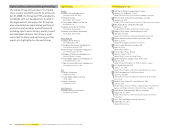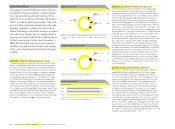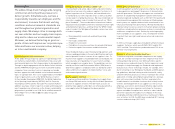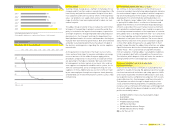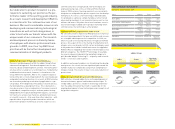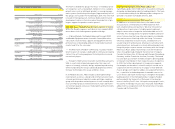Reebok 2008 Annual Report Download - page 70
Download and view the complete annual report
Please find page 70 of the 2008 Reebok annual report below. You can navigate through the pages in the report by either clicking on the pages listed below, or by using the keyword search tool below to find specific information within the annual report.
066 Group Management Report – Our Group Corporate Functions — Global Operations — Sustainability
Focus on fi ve initiatives
Global Operations continues to focus on fi ve key initiatives to
optimise processes in our supply chain:
—
Replenishment: Providing high availability of products to
our customers while minimising our inventory of fi nished
goods.
—
End-to-End Profi tability: Identifying our key cost and
profi tability drivers and their interrelationships to optimise
decision-making.
—
Adaptive Supply Network: Enhancing the fl exibility of both
our sourcing and logistics functions to address quick-
changing market needs.
—
End-to-End Planning: Optimising our Group-wide demand
and supply planning activities to create more effi cient,
transparent and cross-functionally interlinked processes.
—
Accelerated Creation to Shelf: Building capabilities and
technology that drive faster and more effi cient product
creation to enhance the Group’s top- and bottom-line
growth.
Further improvements in short production leadtimes
Our Replenishment programme is essential to support the
growth of own retail and Group-controlled retail space see
Group Strategy, p. 046. This year we further improved our short
production leadtime model with enhanced forecasting and
material planning processes. This also helped to control costs
by reducing risk on material leftovers by about 70%. Further-
more, we started to develop a more retail-friendly set of fulfi l-
ment models, which we will build upon in 2009.
Transparency and predictability in costing increased
In 2008, we faced signifi cant pressure on input costs, and our
End-to-End Profi tability efforts were focused on mitigating
those pressures. Internally, we engineered products differ-
ently with a better appreciation for cost. We continued to meet
regularly with our suppliers to increase transparency and
predictability in costing. For example, we tracked raw mate-
rial costs and used that information to consolidate volumes
and negotiate more effectively which helped to offset cost
increases. In addition, our Sourcing teams improved our
allocation process to better align with suppliers’ capabilities
and take into account total supply chain costs (e.g. time to
market, trade restrictions).
Signifi cant infrastructure implementations
We made signifi cant upgrades to our infrastructure in 2008
as part of our Adaptive Supply Network initiative. We con-
solidated our network of distribution centres and upgraded
facilities. The most notable improvements were our new sites
in Manchester, UK and Spartanburg /South Carolina, USA.
These multi-brand distribution centres represent a further step
in the integration of Reebok into the Group’s infrastructure.
They are state-of-the-art and designed to support the future
growth of our brands and new demands of our own-retail
business. Warehousing will again be a priority in 2009, with
the completion of the US footwear facility in Spartanburg and
also the commencement of planning for a new multi-branded
distribution centre in Russia.
We also improved our process and IT system infrastructure
in 2008 to bring increased fl exibility to our supply chain. One
example is our new Global Procurement System (GPS), a
SAP-based system for purchase order management which
harmonises and simplifi es the ordering process and enables
us to better react to market changes. GPS is the largest SAP
implementation ever undertaken by the adidas Group, and
already replaces four major legacy systems within the Group.
It was implemented for the adidas brand in 2008 and will be
rolled out to the Reebok brand by 2010. Another example within
the Adaptive Supply Network programme is the expansion of
our trading platform in Amsterdam, which brings together our
key supply chain functions across all brands, thus enabling
better visibility, more control and improved risk management
capabilities across our supply chain.
Complexity reduced in planning process
Our End-to-End Planning initiatives focused this year on imple-
menting an optimised demand planning process and system to
19 countries in Europe. We standardised and partly automated
certain planning steps, with the intention of increasing forecast
accuracy. After the initial implementation in 2008 for brand
adidas, we will continue to roll this platform out to all European
countries for adidas and Reebok in 2009.
Creation to shelf timelines cut
We expanded our Accelerated Creation to Shelf initiative in
2008 to bring more products onto shortened creation calen-
dars. We have introduced key acceleration initiatives, including
process simplifi cations and an increasing use of virtual proto-
typing technology, at our creation centres around the world.
These initiatives have already impacted timelines, for example
with a 25% reduction in the creation timeline of the Portland
creation centre. This represents a signifi cant change in our
business, with nearly 60% of our Sport Performance products
on these shortened timelines.








